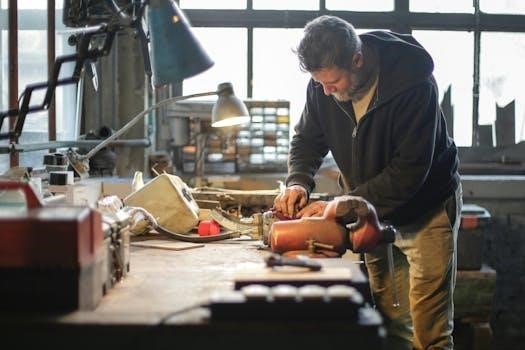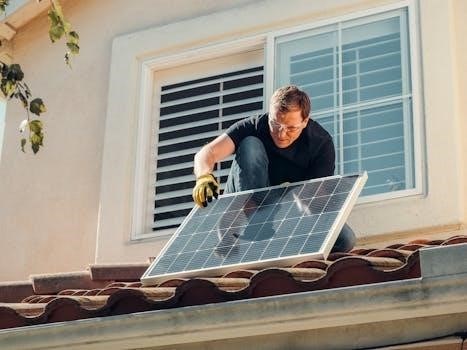Honeywell TH6220U2000 Installation Manual PDF⁚ A Comprehensive Guide
This comprehensive guide provides a deep dive into the Honeywell TH6220U2000 thermostat, focusing on the installation manual in PDF format. It will cover everything from initial setup and wiring to troubleshooting, ensuring a smooth and efficient thermostat installation process.
The Honeywell TH6220U2000, also known as the T6 Pro Programmable Thermostat, is a reliable device designed for efficient temperature control in both residential and commercial settings. It offers a blend of user-friendly features and programmable options, allowing users to customize their heating and cooling schedules for optimal comfort and energy savings. Compatible with various systems, including heat pumps and multi-stage configurations, it supports gas, oil, electric, and forced air setups.
This thermostat features a clear, backlit display for easy readability and intuitive menu navigation. The programmable functionality allows users to set different temperature settings throughout the day, adapting to personal preferences and occupancy patterns. A temporary or permanent override feature provides immediate temperature adjustments without disrupting the programmed schedule.
The Honeywell TH6220U2000 offers versatile scheduling options, including day-to-day, weekend-only, or a consistent weekly program. It is essential to ensure compatibility with your specific system before installation to guarantee proper functionality. This comprehensive guide will walk you through the setup, wiring, and troubleshooting of the TH6220U2000 thermostat, ensuring a seamless integration into your home or business.
Package Contents and Included Components
Upon opening the Honeywell TH6220U2000 thermostat package, you should find several essential components required for a successful installation. The primary item is the T6 Pro Thermostat itself, which serves as the control interface for your heating and cooling system. Accompanying the thermostat is the UWP (Universal Wall Plate) mounting system, designed for easy and secure attachment to the wall.

The package also includes screws and anchors necessary for mounting the UWP to the wall. These fasteners ensure a stable and reliable connection. Additionally, you will find an installation (J-box) adapter, which facilitates mounting the thermostat to a standard junction box. A small decorative cover plate is provided, which can be used to conceal any gaps or imperfections around the installed thermostat.
To power the thermostat, two AA batteries are included. These batteries can serve as the primary power source or as a backup in case of a power outage. The package also contains essential documentation, including an Installation Guide and a User Guide. These guides provide detailed instructions and information on installation, setup, and operation of the thermostat. Ensure all components are present before proceeding with the installation process.
UWP Mounting System Installation
The UWP (Universal Wall Plate) mounting system simplifies the installation of the Honeywell TH6220U2000 thermostat. Before commencing, ensure the power is turned off at the breaker box or switch to prevent electrical hazards. Begin by opening the package to locate the UWP. Position the UWP on the wall at the desired location, ensuring it is level.

Mark the positions for the mounting holes using a pencil or marker. Drill holes at the marked positions, using a drill bit size appropriate for the provided wall anchors. Lightly tap the supplied wall anchors into the drilled holes. Secure the UWP to the wall using the provided screws, ensuring they are properly aligned with the anchors.
For red anchors, use 3x supplied screws (8 1-1/2), and for yellow anchors, use 6 1-1/2 screws. Tighten the screws until the UWP is firmly attached to the wall, but avoid over-tightening, which could damage the anchors or the UWP. The UWP should be securely mounted and level before proceeding with wiring and thermostat attachment. The design ensures easy mounting for homeowners. This system is designed to be easy for both DIY enthusiasts and professional installers.
Wiring Terminal Designations
Understanding the wiring terminal designations is crucial for the correct installation of the Honeywell TH6220U2000 thermostat. Each terminal is labeled with a specific letter or abbreviation that corresponds to a particular function within the heating and cooling system. Common terminal designations include “R” for power, “W” for heat, “Y” for cooling, and “G” for the fan.
The “C” terminal is often used for the common wire, providing a stable power source for the thermostat. In heat pump systems, terminals like “O” or “B” are used to control the reversing valve, determining whether the system operates in heating or cooling mode. Multi-stage systems may have additional terminals such as “W2” or “Y2” for second-stage heating or cooling.
It is essential to consult the wiring diagrams provided in the installation manual to identify the correct terminals for your specific heating and cooling system configuration. Incorrect wiring can lead to improper thermostat operation, damage to the system, or even electrical hazards. Always double-check the wiring connections and ensure they are secure before powering on the thermostat. Remove wires by depressing the terminal tabs. It’s also important to note the voltage requirements to prevent damage.
Wiring for Conventional Systems (Forced Air and Hydronics)
When wiring the Honeywell TH6220U2000 for conventional systems like forced air and hydronic setups, it’s crucial to follow the specific wiring diagrams provided in the installation manual. Conventional systems typically involve simpler wiring configurations compared to heat pump systems. For forced air systems, the “R” terminal connects to the 24VAC power supply, “W” connects to the heating system, “Y” connects to the cooling system, and “G” controls the fan.
Hydronic systems, which use hot water or steam for heating, may have slightly different wiring requirements. The “W” terminal will still control the heating system, but there might not be a “Y” terminal for cooling if the system is heating-only. In some cases, a zone valve may need to be wired in conjunction with the thermostat to control the flow of hot water to specific areas.
It is essential to identify the type of conventional system you have and consult the appropriate wiring diagram in the manual. Ensure all connections are secure and that the wires are properly inserted into the terminals. Incorrect wiring can lead to system malfunction or damage. Always turn off the power at the breaker box or switch before starting any wiring work. It’s also beneficial to label the wires before disconnecting them from the old thermostat to avoid confusion during the new installation.
Thermostat Mounting Guidelines
Proper thermostat mounting is essential for accurate temperature sensing and optimal performance of the Honeywell TH6220U2000. The thermostat should be mounted on an interior wall, away from direct sunlight, drafts, and heat sources such as lamps or appliances. Avoid mounting it on an exterior wall, as this can lead to inaccurate temperature readings due to temperature fluctuations.
The ideal height for mounting the thermostat is approximately one and a half meters above the floor. This height ensures that the thermostat is at a level where it can accurately sense the average room temperature. Before mounting, ensure the wall surface is clean and free of any debris. Use the UWP mounting system included with the thermostat for easy and secure installation.

Level the UWP on the wall and mark the hole positions for the screws. Drill holes at the marked positions and lightly tap the supplied wall anchors into the holes. Secure the UWP to the wall using the provided screws, being careful not to overtighten them. Once the UWP is securely mounted, you can proceed with wiring the thermostat according to the wiring diagrams in the installation manual. Proper mounting ensures accurate temperature readings and efficient operation of the heating and cooling system.
System Operation Settings Configuration
Configuring the system operation settings on the Honeywell TH6220U2000 is crucial for tailoring the thermostat’s performance to your specific heating and cooling system. Access the Installer Setup (ISU) menu to adjust parameters such as the system type, heat stages, and cool stages. These settings ensure the thermostat communicates effectively with your HVAC equipment.
To enter the ISU menu, press and hold the center button and the fan button simultaneously for approximately three seconds. Use the arrow buttons to navigate through the various settings. For conventional systems, select the appropriate settings for forced air or hydronic heating. Configure the number of heat and cool stages to match your system’s capabilities.
Additionally, adjust the cycle rates and temperature swings to optimize comfort and energy efficiency. Finer adjustments to these parameters can prevent temperature overshoot and improve energy use. Review the installation manual for detailed explanations of each setting and recommended values for different system configurations. Proper configuration of these settings ensures that the thermostat operates efficiently and accurately, providing consistent comfort while minimizing energy consumption.
Installer System Test Procedures
After completing the installation and system operation configuration of the Honeywell TH6220U2000 thermostat, performing the installer system test procedures is essential. These tests verify that the thermostat is correctly wired and communicating with the heating and cooling equipment. Access the system test mode through the Installer Setup (ISU) menu to initiate these procedures.
The system test mode allows you to manually activate heating and cooling stages to confirm proper operation. Test each stage of heating and cooling to ensure the equipment responds as expected. Verify that the fan operates correctly in both auto and on modes. Monitor the temperature readings to confirm accurate sensing and control.
During the test, listen for any unusual noises or malfunctions in the HVAC equipment. If any issues arise, double-check the wiring connections and system configuration settings. Consult the installation manual for troubleshooting tips and guidance. Completing these tests ensures that the thermostat is functioning correctly, providing optimal comfort and energy efficiency. Document the test results for future reference and maintenance purposes. Proper testing validates the installation, minimizing potential problems and maximizing the lifespan of the system.
Troubleshooting Common Issues
Even with careful installation, some issues may arise with the Honeywell TH6220U2000 thermostat. A common problem is the thermostat not responding or displaying a blank screen. This could indicate a power issue, so check the batteries or wiring connections. If the thermostat is not maintaining the set temperature, ensure the system mode is correctly set to heat or cool.
Another issue is the thermostat displaying error messages, such as “Check System” or an exclamation point in a triangle. These messages often indicate a problem with the HVAC equipment or wiring. Consult the installation manual for specific error code meanings and troubleshooting steps. If the fan is not working correctly, verify the fan mode setting and wiring connections.
Inconsistent temperature readings can also be a problem. Make sure the thermostat is not located in direct sunlight or near a heat source. If issues persist, try resetting the thermostat to its factory settings. For more complex problems, consider contacting a qualified HVAC technician. They can diagnose and resolve any underlying issues with the thermostat or HVAC system. By systematically troubleshooting, many common problems can be resolved, ensuring proper thermostat function.
Optional Cover Plate Installation
The Honeywell TH6220U2000 thermostat offers an optional cover plate, useful for covering any paint gaps or marks left from the previous thermostat. Before starting, ensure the power to the thermostat is turned off at the breaker box.
Begin by carefully aligning the cover plate with the UWP (Universal Wiring Plate) mounting system. Use the supplied screws from the cover plate kit, typically eight 1-1/2″ screws for red anchors or six 1-1/2″ screws for yellow anchors, to secure the cover plate to the wall. Insert the screws through the cover plate and into the wall anchors, tightening them gently to avoid over-tightening.
Once the cover plate is securely mounted, attach the UWP by hanging it on the top of the cover plate and then snapping the bottom into place. This ensures a clean and finished look. If using a rectangular cover plate, follow the specific instructions included with that kit for proper alignment and attachment. The cover plate enhances the aesthetic appeal of the installation.
Power Options for the Thermostat
The Honeywell TH6220U2000 thermostat offers flexible power options to suit various installation needs. Primarily, it can be powered using a 20 to 30 VAC (Alternating Current) power supply. This is the recommended method for most installations, ensuring reliable and consistent operation of the thermostat.
As a secondary option, the thermostat supports battery power, utilizing two AA batteries. These batteries serve as either the primary power source in situations where a wired connection is not feasible or as a backup power source to maintain thermostat operation during power outages.
When using batteries, ensure they are correctly inserted following the polarity markings inside the battery compartment. Regularly check the battery levels and replace them as needed to avoid interruptions in thermostat functionality. The thermostat will typically display a low battery indicator when replacement is necessary. Using batteries provides added reliability and peace of mind, especially in areas prone to power disruptions.

Understanding Thermostat Display and Controls
The Honeywell TH6220U2000 thermostat features a user-friendly interface designed for easy operation and clear information display. The primary display shows essential information, including the current room temperature, the setpoint temperature, and the system mode (Heat, Cool, Auto, or Off).
The thermostat utilizes several buttons for navigation and control. The “Mode” button allows users to cycle through the available system modes, selecting the appropriate setting for heating, cooling, or automatic operation. The “Fan” button controls the fan operation, with options for “Auto,” “On,” and “Circ” (Circulate).
Arrow buttons are used to adjust the setpoint temperature, increasing or decreasing it to the desired level. The “Schedule” button provides access to the programming menu, allowing users to set up custom heating and cooling schedules for different times of the day and days of the week. Additional indicators on the display may include a low battery warning, alerts, or hold settings. Understanding these controls is crucial for effectively managing your home’s climate.
Accessing and Navigating the Installer Setup (ISU) Menu
The Installer Setup (ISU) menu on the Honeywell TH6220U2000 thermostat provides access to advanced configuration settings, allowing installers and experienced users to fine-tune the thermostat’s operation to match the specific heating and cooling system.
To access the ISU menu, press and hold the “Center” button and either the up or down arrow button for approximately three seconds. This will enter the advanced settings mode. Use the “Select” button to enter the ISU (Installer Setup) section.
Within the ISU menu, you’ll find various parameters that can be adjusted, such as the system type, number of heating and cooling stages, temperature swing settings, and other advanced options. Use the arrow buttons to navigate through the list of available settings. When a desired setting is highlighted, press the “Select” button to view its current value and make adjustments. Use the arrow buttons to change the value, and press “Select” again to save the new setting.
Carefully consult the installation manual for detailed explanations of each setting and its impact on system performance. Incorrect settings can lead to inefficient operation or even damage to the heating and cooling equipment.